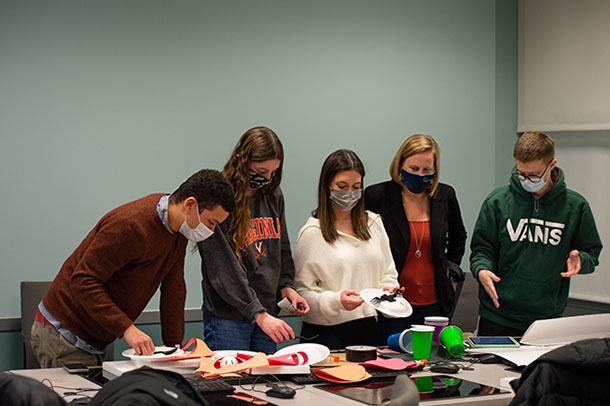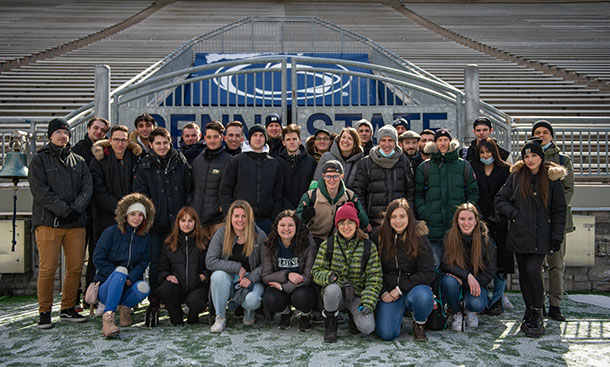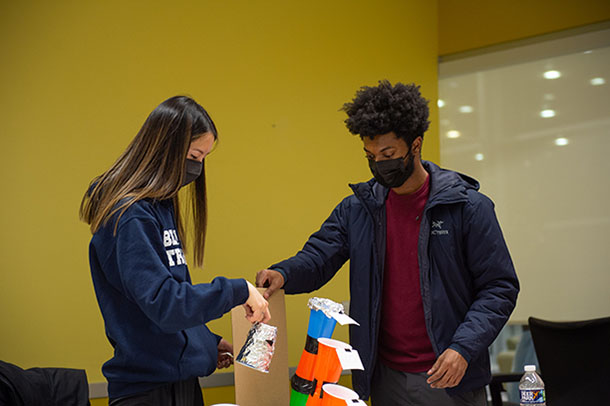By Sarah Small
UNIVERSITY PARK, Pa. — In an increasingly connected world, professional skills like cooperation, collaboration and global competency are paramount. For students participating in the Center for Global Engineering Engagement's Como, Italy, “Cross-cultural Engagement and Technical Presentation Program” and in the Engineering Leadership Development course ENGR 422: Leadership of International Virtual Engineering Teams, collaborating internationally is part of the classroom experience.
The Center for Global Engineering Engagement (GEE) and Engineering Leadership Development (ELD) hosted a delegation of 25 students and faculty from the University of Applied Sciences and Arts of Southern Switzerland’s (SUPSI) Mendrisio and Lugano campuses for a week of events and workshops to kick off semester-long collaborative projects with Penn State students. The SUPSI students from Lugano are working with the students from ENGR 422, and students from Mendrisio are participating in the GEE program. The students from all three locations will work on these projects virtually until the Penn State students travel to Switzerland and Italy in May.
According to Meg Handley, associate director of ELD undergraduate programs and associate teaching professor in the School of Engineering Design, Technology, and Professional Programs (SEDTAPP), the partnership between Penn State and SUPSI was facilitated through GEE, with the help of Patrick Tunno, director of GEE, and Lori Miraldi, director of the Engineering Ambassadors Program.
“The various activities during this visit were aimed at helping students connect across cultures and to provide an opportunity for the SUPSI students to experience Penn State culture,” Handley said. “The Engineering Leadership Symposium held during the week of the visit was organized by the Engineering Leadership Society — our student-run organization of the ELD program. This event provided students with the opportunity to apply their newly acquired leadership skills to a design challenge.”

Meg Handley, associate director of ELD undergraduate programs and associate teaching professor in the School of Engineering Design, Technology, and Professional Programs (second from right), discusses a design challenge project with students from SUPSI and the ELD course. Credit: Kelby Hochreither/Penn State
The projects in this section of the course focus on “re-imagining consumer experiences to expose, educate and develop new ways of consuming that reduce emissions by the individual, household or business,” according to the course objectives. The two main problem models are the circular economy — a model of recycling objects to maximize their use — and individual, household or business consumption reduction.
“Working with teams is crucial in the engineering world,” said Akhdan Mir, a student in the course who is majoring in energy engineering. “Being able to work with individuals who aren't from the United States, we get experience and knowledge of how to communicate and collaborate with others from different countries and cultures. What I hope to get out of this course is the ability to demonstrate engineering project collaboration and leadership skills. I also hope to grow as a student leader and set myself up for success as an engineer with both technical and nontechnical skills in industry.”
Tunno said that the collaboration fits with the College of Engineering’s strategic goals of building a network of strategic international partnerships.
“We strive to make meaningful connections between the college and global institutional partners for teaching, research and service,” he said. “Building programs that connect students from around the world promotes intercultural competence. The students will have several months to learn from each other, whether it’s culture, foreign language or engineering concepts. We love this because it allows them to develop global competencies needed to solve the world’s most pressing engineering challenges and of course make the most of their time abroad.”

Students from the Swiss delegation and the ELD course toured Penn State's Beaver Stadium as part of the week-long visit from the international group. Credit: Kelby Hochreither/Penn State




